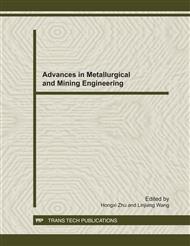p.432
p.436
p.442
p.446
p.452
p.457
p.463
p.467
p.472
Study on Mechanism of Desulfurization by Spent Zn-MnO2 Batteries
Abstract:
The mechanism of a novel desulfurization method using spent Zn-MnO2 batteries has been studied by X-ray diffraction(XRD), scanning electronic microscopy (SEM), energy dispersive spectrometry (EDS) and the experiments of SO2 absorption. The XRD results show that the positive electrode of spent Zn-MnO2 batteries consists of a mixture of α-MnO2, Mn2O3 and Mn3O4 phase. The SEM results show that micropores and microparticles are observed in the positive electrode surface, the relative content of zinc and graphite increases in the positive electrode after discharging according to EDS. The results of absorption experiments show that the electrolyte of spent batteries is of weak alkali which verifies the feasibility of absorbing SO2 using spent Zn-MnO2 batteries. Furthermore, the solution obtained by washing the positive electrode with low concentration ammonia is of much better desulfurization efficiency than that with distilled water directly, and 40°C is the optimum to absorb SO2 at a range of 30-70°C.
Info:
Periodical:
Pages:
452-456
Citation:
Online since:
November 2011
Authors:
Keywords:
Price:
Сopyright:
© 2012 Trans Tech Publications Ltd. All Rights Reserved
Share:
Citation:


